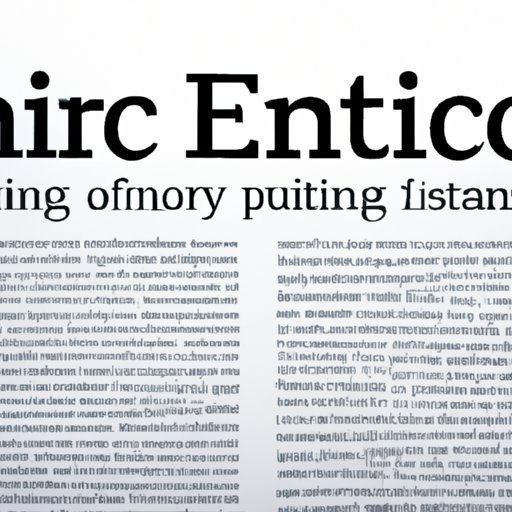Introduction
Editorial writing is a type of opinion writing in which authors present their own views and opinions about a particular issue or subject. This type of writing typically appears in newspapers, magazines, and other print media outlets. It is used to provide an informed analysis of the current events and news topics, as well as to express personal opinions and commentaries. The purpose of editorial writing is to engage readers with meaningful discourse and to help shape public opinion on important issues.

Overview of Editorial Writing: What Is It and How to Do It
Editorial writing can be broken down into four main components: research, facts & figures, opinion & argumentation, and clarity & structure. To write an effective editorial, one must first conduct extensive research on the topic at hand. It is important to be aware of the most up-to-date information and news related to the topic. Once the research has been conducted, the writer should then assemble facts and figures to support their argument. Next, they must express their opinion and make a compelling argument to back it up. Finally, it is essential to ensure that the piece is clear and organized.
In addition to the components of editorial writing, there are also several techniques that can be used to make sure the editorial is effective. It is important for the writer to know their audience and understand what kind of message they are trying to communicate. Developing a strong point-of-view is also key in order to make a compelling argument. Crafting the language used in the piece is also important; using language that is both clear and concise will ensure that the reader is able to easily understand the message being conveyed.

A Guide to Writing Effective Editorials
Writing an effective editorial requires a few simple steps. First, it is important to set the context and identify the focus of the piece. This will help the writer stay on track while writing the editorial. Next, creating an outline will help the writer organize their thoughts and ensure that all the necessary points are covered. After the outline is complete, the writer can start drafting the piece. Once the first draft is finished, it is important to go back and revise and edit the writing. This will help ensure that the piece is clear and concise.
Exploring the Different Types of Editorial Writing
There are three primary types of editorial writing: op-eds, columns, and reviews. Op-eds are typically short pieces that focus on a single topic or issue. Columns, on the other hand, are longer pieces that are written on a regular basis and are usually focused on a specific topic. Reviews are editorials that critique a particular product, service, or event. All three types of editorial writing share the same basic components and techniques, but each type has its own unique purpose and style.

The Power of Opinion: Why Editorial Writing Matters
Editorial writing is an important tool for expressing freedom of expression. Through editorial writing, individuals are able to engage with society and share their thoughts and feelings on a variety of topics. Additionally, editorial writing can help structure debate and discussion around important issues. By providing a platform for individuals to express their opinions, editorial writing helps to foster dialogue and encourage participation in the democratic process.
Crafting Your Own Voice Through Editorial Writing
Writing editorials can be a great way for individuals to establish their own identity and values. When crafting an editorial, it is important to understand your viewpoint and clearly communicate your message. Doing so will help you create an editorial that reflects your beliefs and values, and will allow you to effectively engage with your audience.
Conclusion
Editorial writing is a powerful tool for expressing freedom of expression and engaging with society. It is an important form of opinion writing that allows individuals to research and analyze current events, express their own views and opinions, and craft compelling arguments. There are several different types of editorial writing, each with its own unique purpose and style. By understanding the components and techniques of editorial writing, one can craft their own voice and effectively communicate their message.
(Note: Is this article not meeting your expectations? Do you have knowledge or insights to share? Unlock new opportunities and expand your reach by joining our authors team. Click Registration to join us and share your expertise with our readers.)
